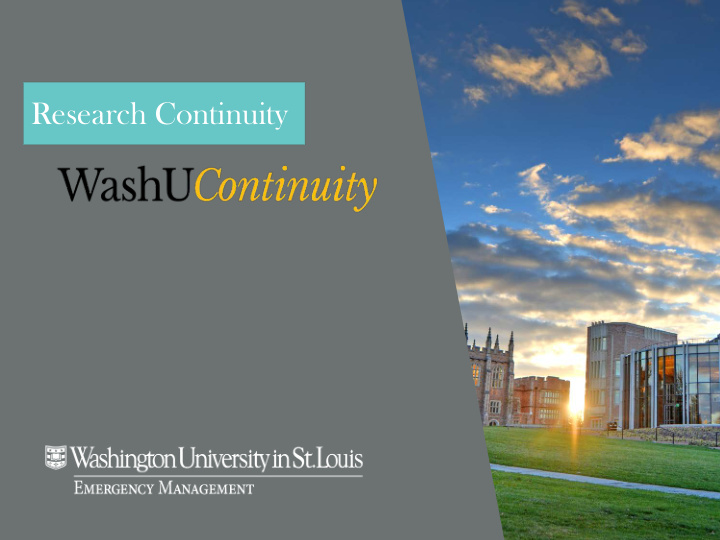



Research Continuity
Goals • Focus your planning efforts • Thinking inward rather than just externally about continuity • Clarity to your roles and responsibilities in a continuity incident • Build a culture of continuity
Building Fire Scenario • An electrical short in the middle of your area of the building starts a fire. • There is heavy smoke and fire damage on your floor and the floors above, and heavy water damage on the floors below. • All workspace, PCs, supplies, documents, and equipment has been destroyed. • About half of your employees remain near the building, the other half are unaccounted. • The Fire Department cleared the building and has cordoned off the building and NO ONE will be allowed in or out for at least 7 days.
Phases of an Incident
Loss & Restrictions Triangles Restrictions Loss Triangle Triangle Things Time
Combination of Loss and Restriction Constraints
Planning Priorities • Scope and Cost – Focus on essential functions and processes • Time – Focus on those things that need to be continued immediately • Things – Identify only critical things needed to support essential functions • People – Identify essential personnel needed to support essential functions • Locations – Identify only those locations needed to support essential functions
Capabilities Triangle “How” Procedures
Increase Resource Capabilities • Develop recovery strategies or workarounds • Resources – IT applications – Staff – Locations – Vital documents – Equipment – Supplies
Laboratory Research Considerations • How long the experiment can be left status quo before it can become dangerous? • What equipment (if any) needs to be turned off or on? • How long you can be out of the lab when it is left in mid- ‐ operations before the potential exist of losing critical equipment, experiments, animals etc.? • Do any of the research materials or animals etc., have to be evacuated? • Key information on grants- ‐ If you are unable to continue operating, how does this affect any grant or federal requirements?
Laboratory Research Considerations • List of equipment and utility requirements • Duplicate copies of drawings, diagrams, plans, or specifications of unique equipment • Duplicate samples of novel compounds and specimens • Irreplaceable specimens (animals, plants, cell lines, DNA etc.) copied/duplicated and distributed to sites outside of your lab • Do you have procedures for data storage and management?
Increase Procedures Capabilities • Communications • Actions to implement recovery strategies – Loss of power – Loss of water – Loss of access to building – Loss of staff – Loss of vendors – Loss of critical resources – Loss of IT applications
Increase Competencies Capabilities • Crisis fortitude • Leadership • Performance • Shared Vision • Teamwork
Building Fire Scenario (Revisited) • What is your role in this scenario? • What is your scope of operations? • What do you think your internal staff will value most following this scenario? • Who goes home? • Who do you call for resources?
Family Continuity • Transportation • Communication • Childcare
4 Key Takeaways Focus our time and efforts on capabilities Clarity to your roles and responsibilities within continuity Think inward rather than just externally Build a culture of continuity
Brandon Robbins, MBCP, CEM WashU Continuity Program Manager 812-929-9923 or 314-273-0382 brandon.robbins@wustl.edu
Recommend
More recommend